engine TOYOTA YARIS iA 2017 Owners Manual (in English)
[x] Cancel search | Manufacturer: TOYOTA, Model Year: 2017, Model line: YARIS iA, Model: TOYOTA YARIS iA 2017Pages: 576, PDF Size: 8.9 MB
Page 492 of 576
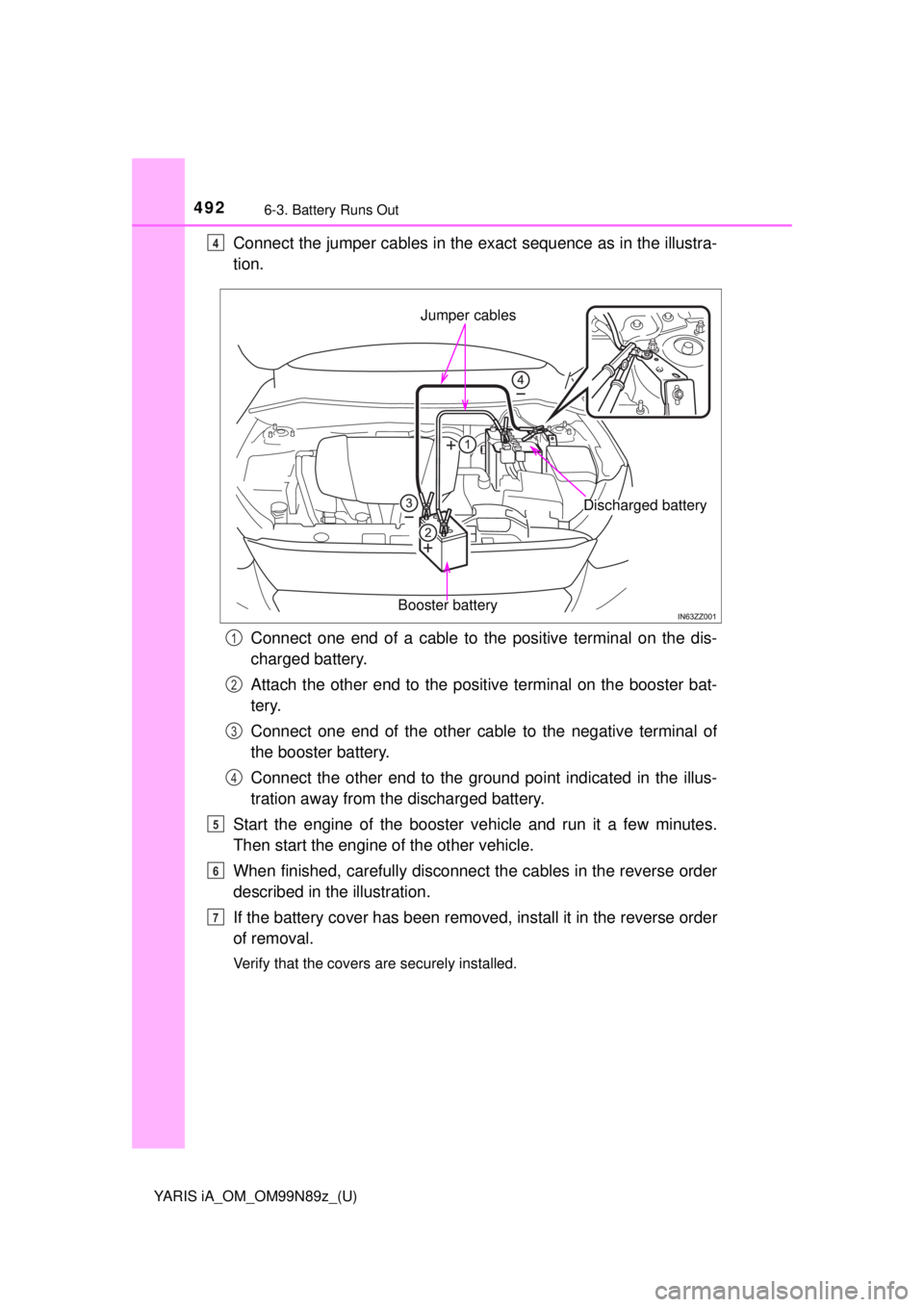
4926-3. Battery Runs Out
YARIS iA_OM_OM99N89z_(U)
Connect the jumper cables in the exact sequence as in the illustra-
tion.
Connect one end of a cable to the positive terminal on the dis-
charged battery.
Attach the other end to the positive terminal on the booster bat-
tery.
Connect one end of the other cabl e to the negative terminal of
the booster battery.
Connect the other end to the ground point indicated in the illus-
tration away from the discharged battery.
Start the engine of the booster v ehicle and run it a few minutes.
Then start the engine of the other vehicle.
When finished, carefully disconnect the cables in the reverse order
described in the illustration.
If the battery cover has been removed, install it in the reverse order
of removal.
Verify that the covers are securely installed.
4
Jumper cables
Booster battery
Discharged battery
1
2
3
4
5
6
7
Page 493 of 576
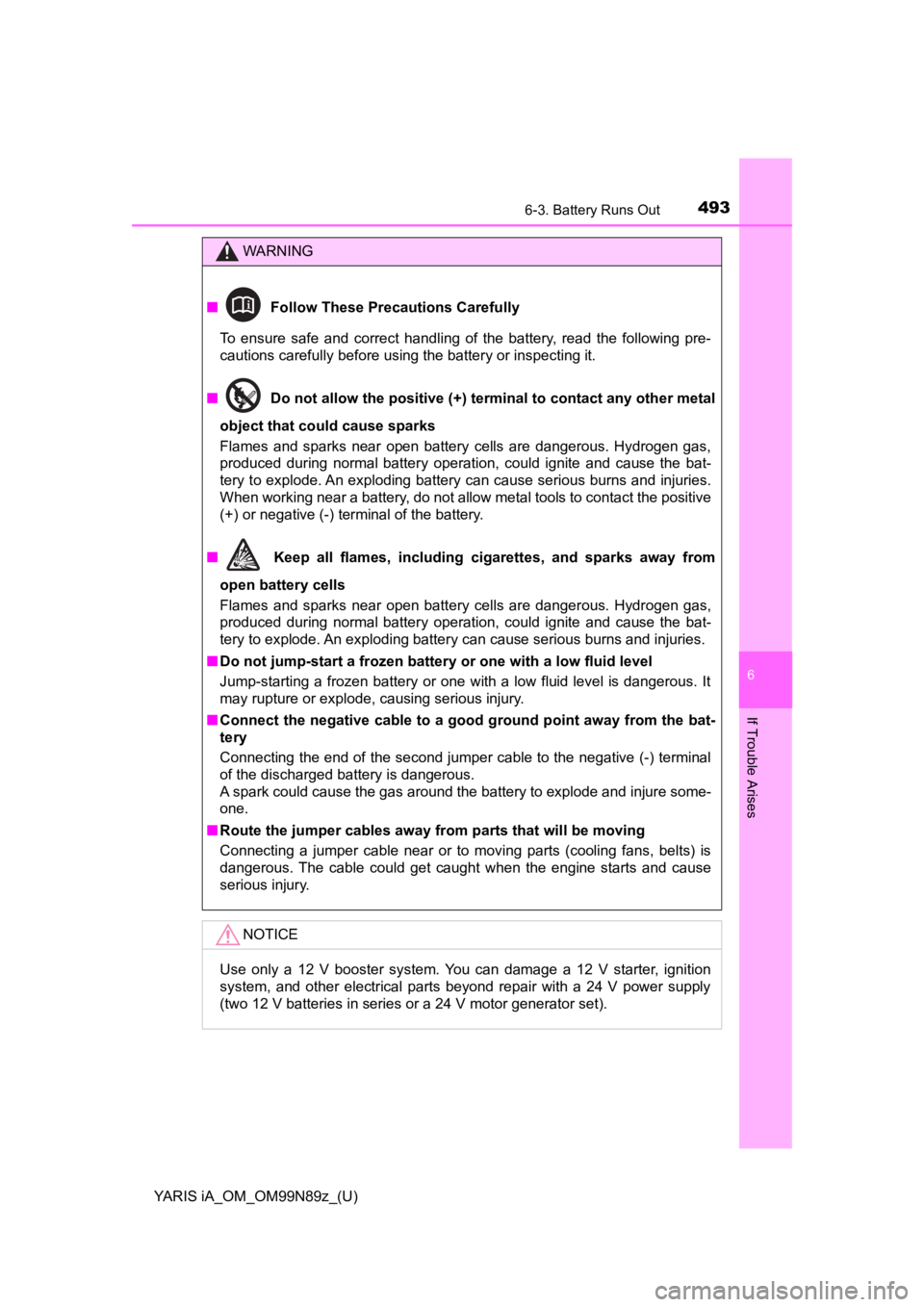
YARIS iA_OM_OM99N89z_(U)
4936-3. Battery Runs Out
6
If Trouble Arises
WARNING
■ Follow These Precautions Carefully
To ensure safe and correct handling of the battery, read the following pre-
cautions carefully before using the battery or inspecting it.
■ Do not allow the positive (+) term inal to contact any other metal
object that could cause sparks
Flames and sparks near open battery cells are dangerous. Hydrogen gas,
produced during normal battery operation, could ignite and cause the bat-
tery to explode. An exploding battery can cause serious burns and injuries.
When working near a battery, do not allow metal tools to contact the positive
(+) or negative (-) terminal of the battery.
■ Keep all flames, including cigarettes, and sparks away from
open battery cells
Flames and sparks near open battery cells are dangerous. Hydrogen gas,
produced during normal battery operation, could ignite and cause the bat-
tery to explode. An exploding battery can cause serious burns and injuries.
■ Do not jump-start a frozen battery or one with a low fluid level
Jump-starting a frozen battery or one with a low fluid level is dangerous. It
may rupture or explode, causing serious injury.
■ Connect the negative cable to a good ground point away from the bat-
tery
Connecting the end of the second jumper cable to the negative (-) terminal
of the discharged battery is dangerous.
A spark could cause the gas around the battery to explode and injure some-
one.
■ Route the jumper cables away fr om parts that will be moving
Connecting a jumper cable near or to moving parts (cooling fans, belts) is
dangerous. The cable could get caught when the engine starts and cause
serious injury.
NOTICE
Use only a 12 V booster system. You can damage a 12 V starter, ignition
system, and other electrical parts beyond repair with a 24 V power supply
(two 12 V batteries in series or a 24 V motor generator set).
Page 494 of 576
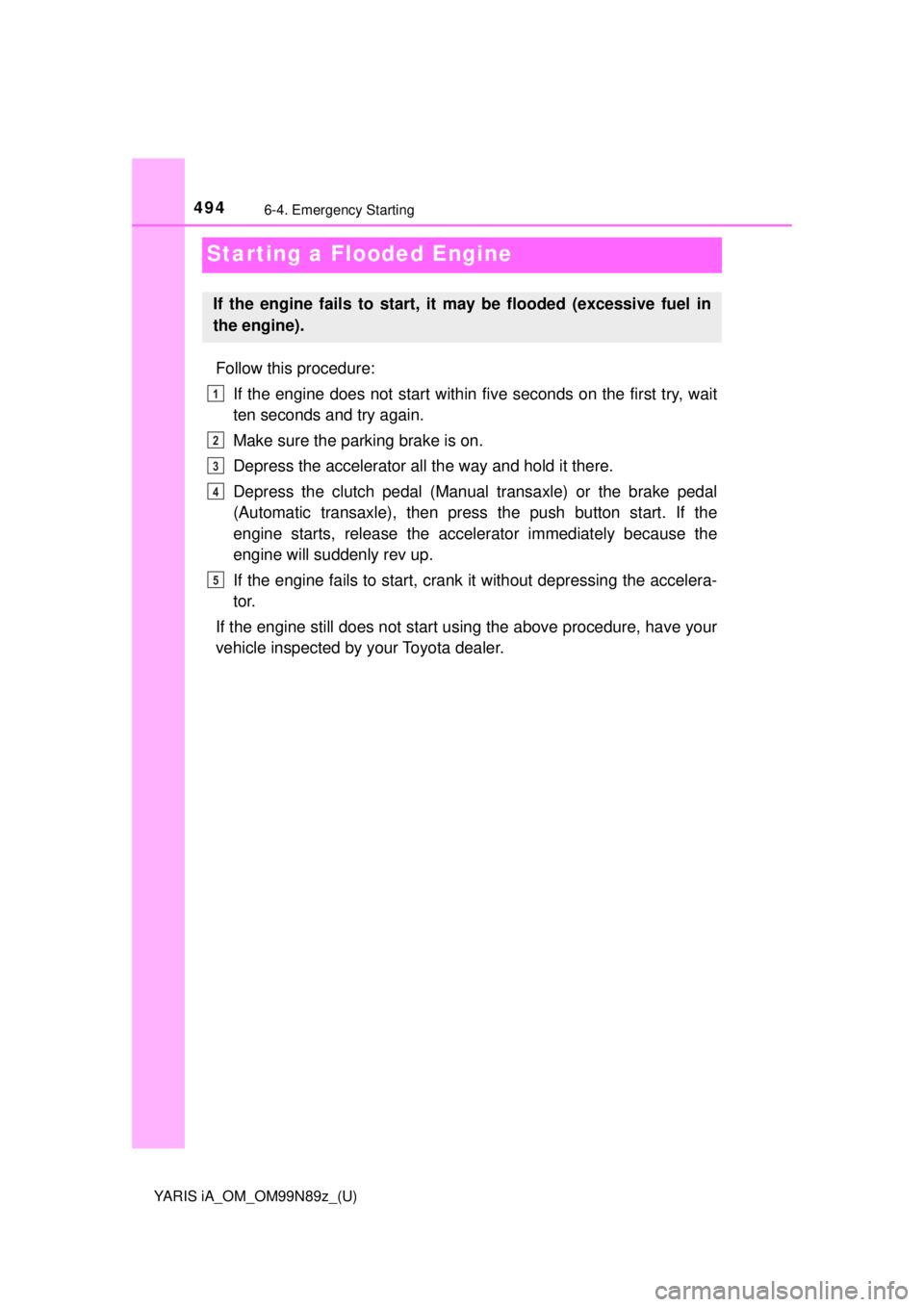
494
YARIS iA_OM_OM99N89z_(U)
6-4. Emergency Starting
Starting a Flooded Engine
Follow this procedure:If the engine does not start within five seconds on the first try, wait
ten seconds and try again.
Make sure the parking brake is on.
Depress the accelerator all the way and hold it there.
Depress the clutch pedal (Manual transaxle) or the brake pedal
(Automatic transaxle), then pres s the push button start. If the
engine starts, release the accele rator immediately because the
engine will suddenly rev up.
If the engine fails to start, crank it without depressing the accelera-
tor.
If the engine still does not start using the above procedure, have your
vehicle inspected by your Toyota dealer.
If the engine fails to start, it may be flooded (excessive fuel in
the engine).
1
2
3
4
5
Page 495 of 576
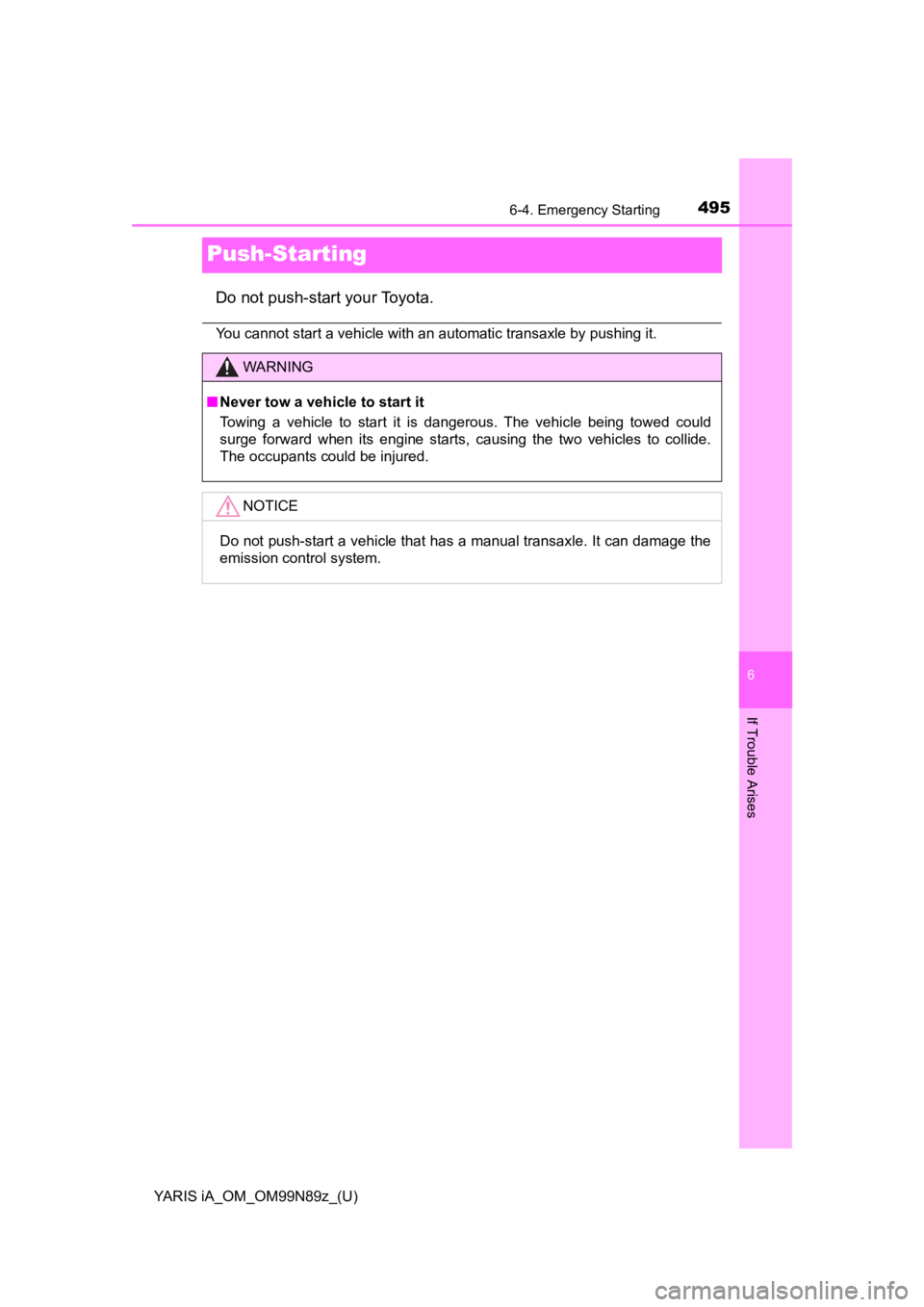
495
YARIS iA_OM_OM99N89z_(U)
6-4. Emergency Starting
6
If Trouble Arises
Push-Starting
Do not push-start your Toyota.
You cannot start a vehicle with an automatic transaxle by pushing it.
WARNING
■Never tow a vehicle to start it
Towing a vehicle to start it is dangerous. The vehicle being towed could
surge forward when its engine starts, causing the two vehicles to collide.
The occupants could be injured.
NOTICE
Do not push-start a vehicle that has a manual transaxle. It can damage the
emission control system.
Page 496 of 576
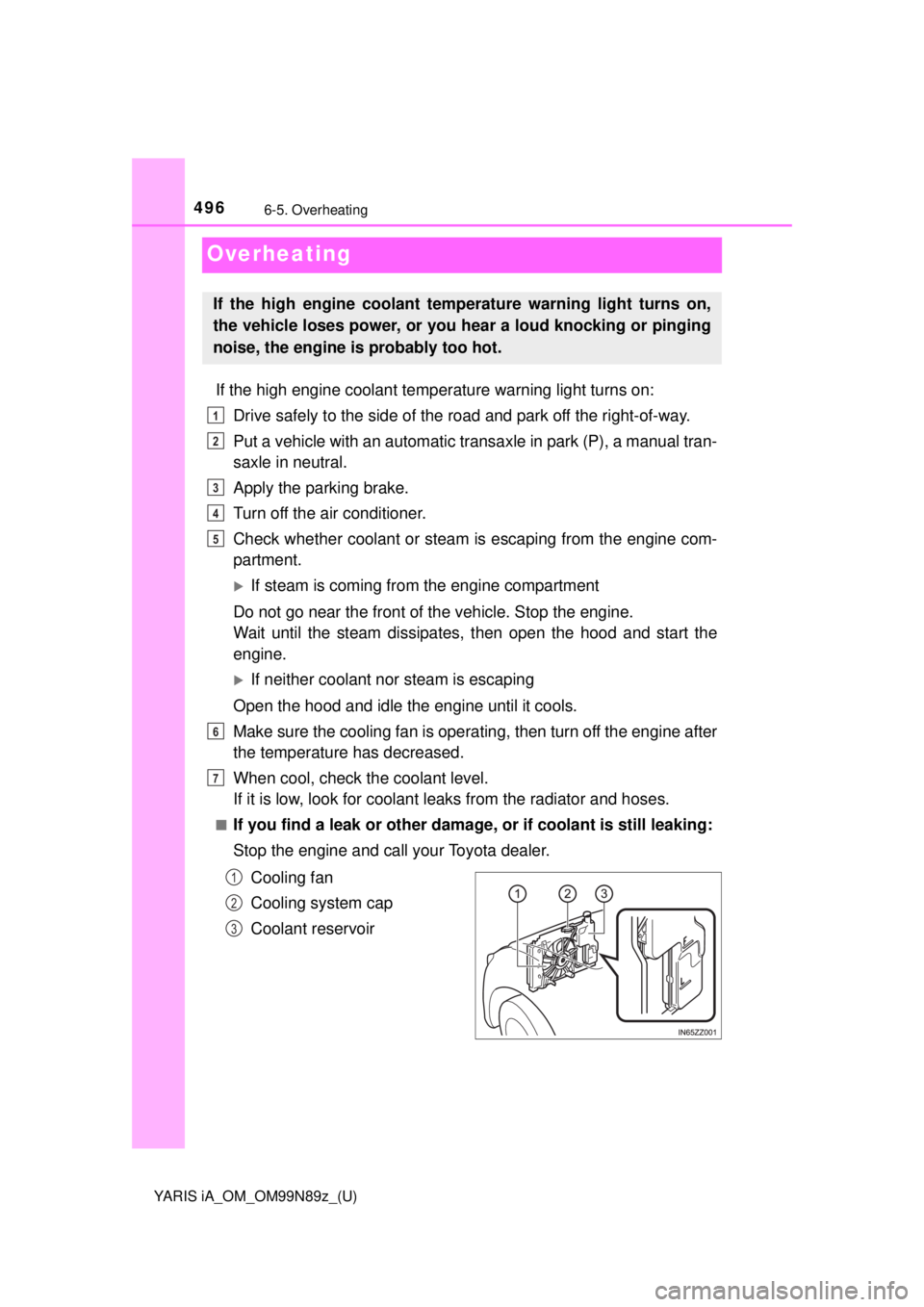
496
YARIS iA_OM_OM99N89z_(U)
6-5. Overheating
Overheating
If the high engine coolant temperature warning light turns on:Drive safely to the side of the road and park off the right-of-way.
Put a vehicle with an automatic tr ansaxle in park (P), a manual tran-
saxle in neutral.
Apply the parking brake.
Turn off the air conditioner.
Check whether coolant or steam is escaping from the engine com-
partment.
If steam is coming from the engine compartment
Do not go near the front of the vehicle. Stop the engine.
Wait until the steam dissipates, then open the hood and start the
engine.
If neither coolant nor steam is escaping
Open the hood and idle the engine until it cools.
Make sure the cooling fan is operating, then turn off the engine after
the temperature has decreased.
When cool, check the coolant level.
If it is low, look for coolant leaks from the radiator and hoses.
■If you find a leak or other damage , or if coolant is still leaking:
Stop the engine and call your Toyota dealer.
Cooling fan
Cooling system cap
Coolant reservoir
If the high engine coolant temperature warning light turns on,
the vehicle loses power, or you hear a loud knocking or pinging
noise, the engine is probably too hot.
1
2
3
4
5
6
7
1
2
3
Page 497 of 576
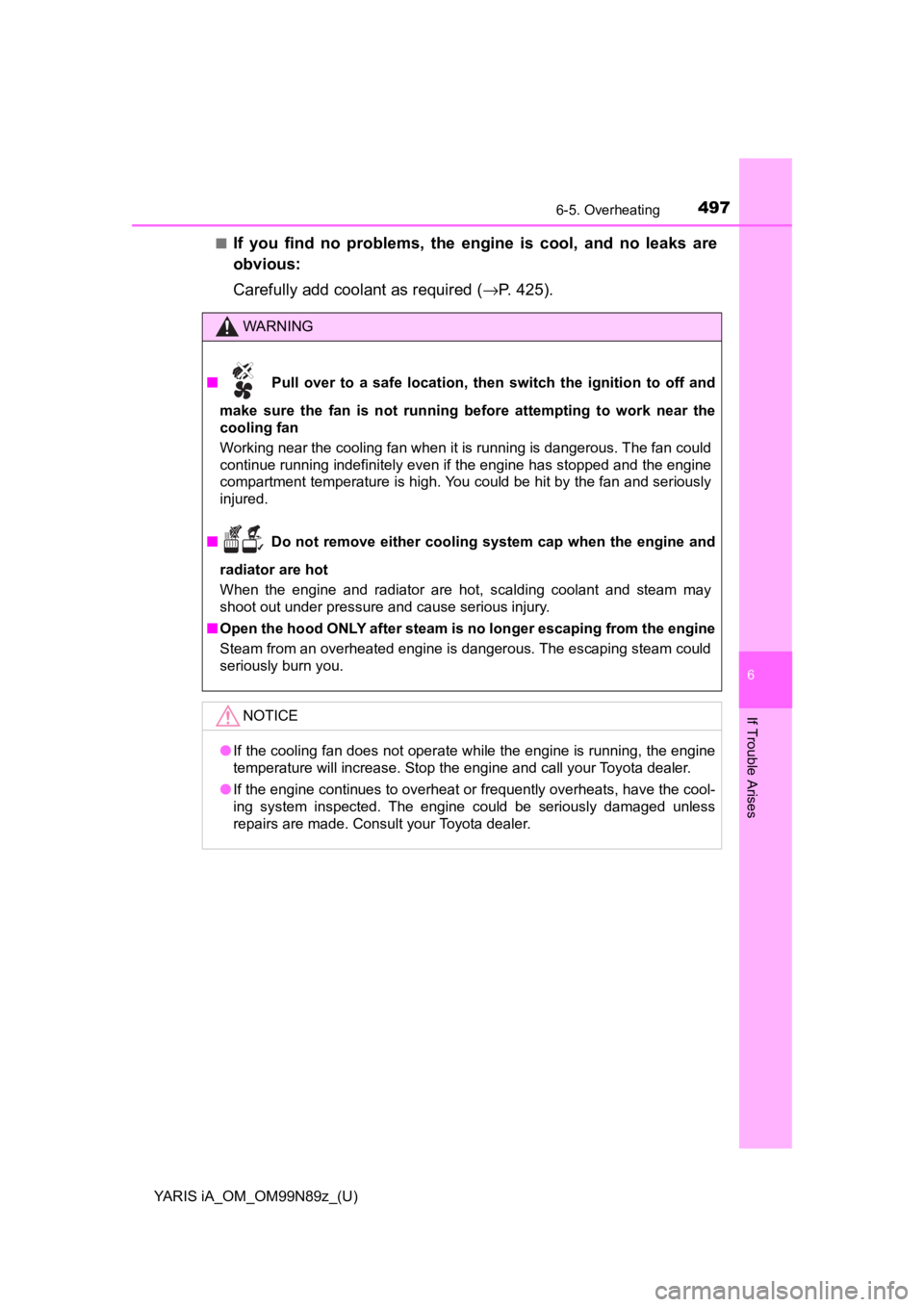
YARIS iA_OM_OM99N89z_(U)
4976-5. Overheating
6
If Trouble Arises
■If you find no problems, the engine is cool, and no leaks are
obvious:
Carefully add coolant as required (→P. 425).
WARNING
■ Pull over to a safe location, then switch the ignition to off and
make sure the fan is not running before attempting to work near the
cooling fan
Working near the cooling fan when it is running is dangerous. The fan could
continue running indefinitely even if the engine has stopped and the engine
compartment temperature is high. You could be hit by the fan and seriously
injured.
■ Do not remove either cooling system cap when the engine and
radiator are hot
When the engine and radiator are hot, scalding coolant and steam may
shoot out under pressure and cause serious injury.
■ Open the hood ONLY after steam is no longer escaping from the engine
Steam from an overheated engine is dangerous. The escaping steam could
seriously burn you.
NOTICE
● If the cooling fan does not operate while the engine is running, the engine
temperature will increase. Stop the engine and call your Toyota dealer.
● If the engine continues to overheat or frequently overheats, have the cool-
ing system inspected. The engine could be seriously damaged unless
repairs are made. Consult your Toyota dealer.
Page 502 of 576
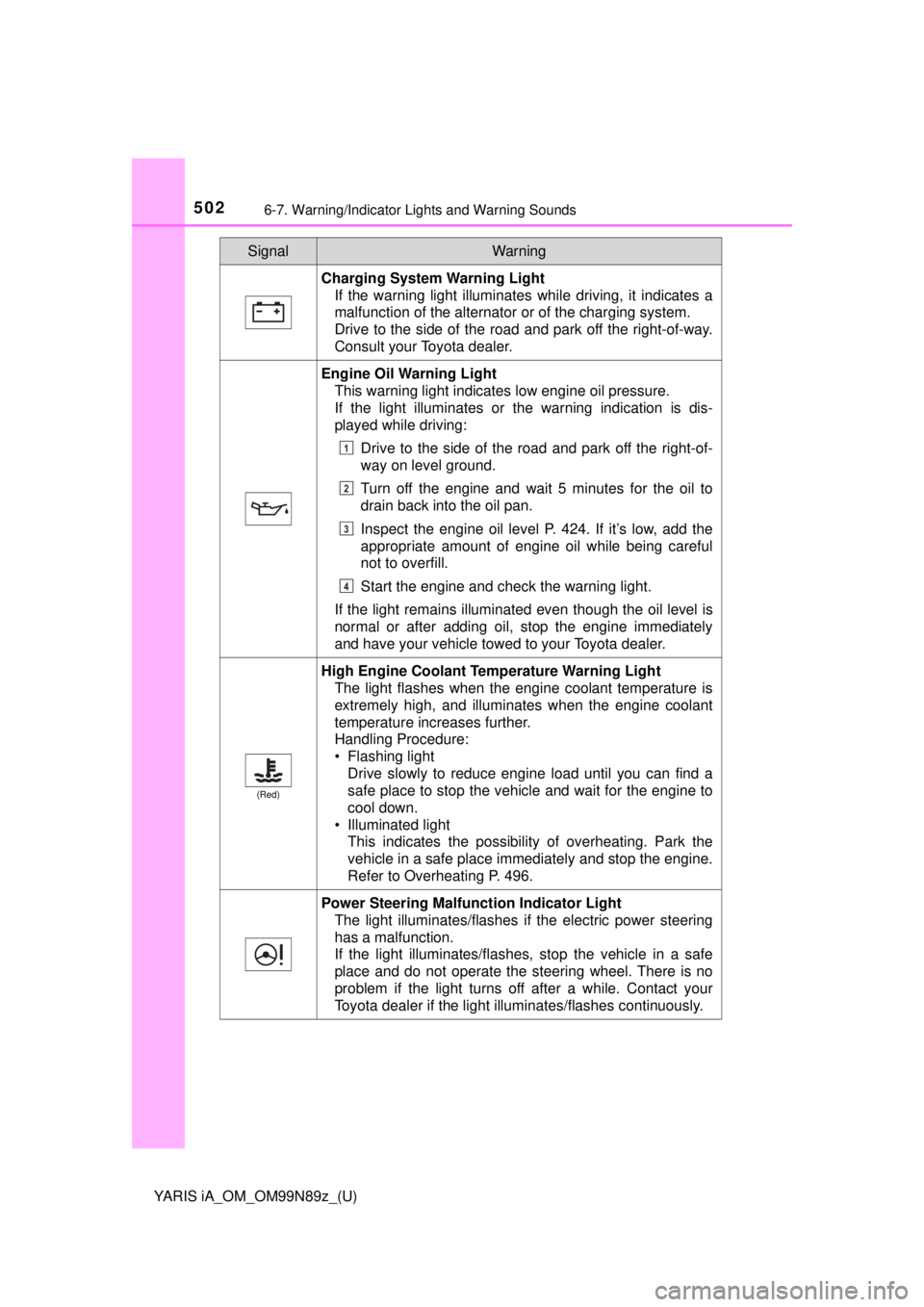
5026-7. Warning/Indicator Lights and Warning Sounds
YARIS iA_OM_OM99N89z_(U)
Charging System Warning LightIf the warning light illuminates while driving, it indicates a
malfunction of the alternator or of the charging system.
Drive to the side of the road and park off the right-of-way.
Consult your Toyota dealer.
Engine Oil Warning LightThis warning light indicates low engine oil pressure.
If the light illuminates or the warning indication is dis-
played while driving:
Drive to the side of the road and park off the right-of-
way on level ground.
Turn off the engine and wait 5 minutes for the oil to
drain back into the oil pan.
Inspect the engine oil level P. 424. If it’s low, add the
appropriate amount of engine oil while being careful
not to overfill.
Start the engine and check the warning light.
If the light remains illuminated even though the oil level is
normal or after adding oil, stop the engine immediately
and have your vehicle towed to your Toyota dealer.
(Red)
High Engine Coolant Temperature Warning Light The light flashes when the engine coolant temperature is
extremely high, and illuminates when the engine coolant
temperature increases further.
Handling Procedure:
• Flashing lightDrive slowly to reduce engine load until you can find a
safe place to stop the vehicle and wait for the engine to
cool down.
• Illuminated light This indicates the possibility of overheating. Park the
vehicle in a safe place immediately and stop the engine.
Refer to Overheating P. 496.
Power Steering Malfunction Indicator Light
The light illuminates/flashes if the electric power steering
has a malfunction.
If the light illuminates/flashes, stop the vehicle in a safe
place and do not operate the steering wheel. There is no
problem if the light turns off after a while. Contact your
Toyota dealer if the light illuminates/flashes continuously.
SignalWarning
1
2
3
4
Page 503 of 576
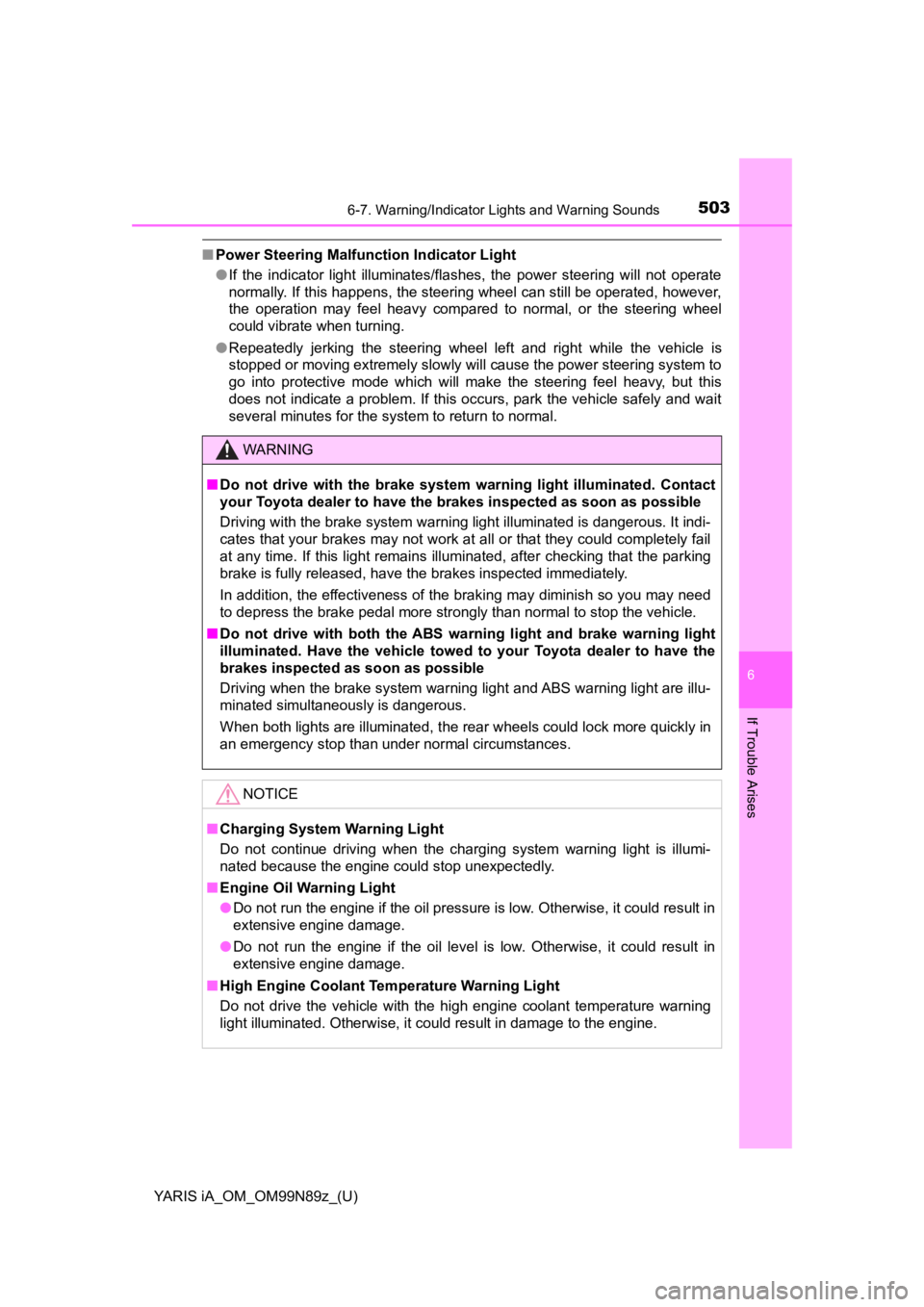
YARIS iA_OM_OM99N89z_(U)
5036-7. Warning/Indicator Lights and Warning Sounds
6
If Trouble Arises
■Power Steering Malfunction Indicator Light
●If the indicator light illuminates/flashes, the power steering will not operate
normally. If this happens, the steering wheel can still be operated, however,
the operation may feel heavy compared to normal, or the steering wheel
could vibrate when turning.
● Repeatedly jerking the steering wheel left and right while the vehicle is
stopped or moving extremely slowly will cause the power steering system to
go into protective mode which will make the steering feel heavy, but this
does not indicate a problem. If this occurs, park the vehicle safely and wait
several minutes for the system to return to normal.
WARNING
■Do not drive with the brake system warning light illuminated. Contact
your Toyota dealer to have the brakes inspected as soon as possible
Driving with the brake system warning light illuminated is dangerous. It indi-
cates that your brakes may not work at all or that they could completely fail
at any time. If this light remains illuminated, after checking that the parking
brake is fully released, have the brakes inspected immediately.
In addition, the effectiveness of the braking may diminish so you may need
to depress the brake pedal more strongly than normal to stop the vehicle.
■ Do not drive with both the ABS warning light and brake warning light
illuminated. Have the vehicle towed to your Toyota dealer to have the
brakes inspected as soon as possible
Driving when the brake system warning light and ABS warning light are illu-
minated simultaneously is dangerous.
When both lights are illuminated, the rear wheels could lock more quickly in
an emergency stop than under normal circumstances.
NOTICE
■Charging System Warning Light
Do not continue driving when the charging system warning light is illumi-
nated because the engine could stop unexpectedly.
■ Engine Oil Warning Light
● Do not run the engine if the oil pressure is low. Otherwise, it could result in
extensive engine damage.
● Do not run the engine if the oil level is low. Otherwise, it could result in
extensive engine damage.
■ High Engine Coolant Temperature Warning Light
Do not drive the vehicle with the high engine coolant temperature warning
light illuminated. Otherwise, it could result in damage to the engine.
Page 504 of 576
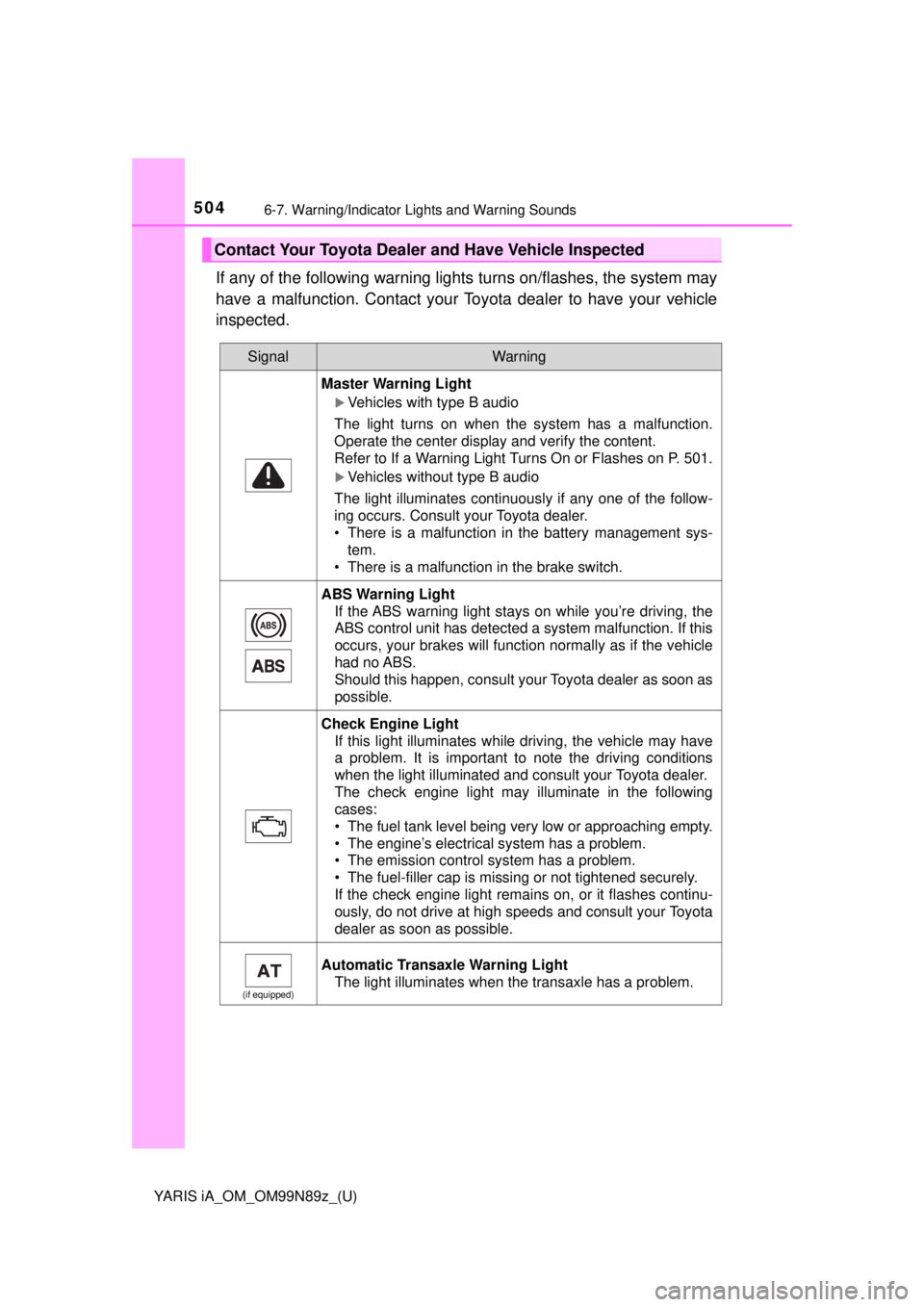
5046-7. Warning/Indicator Lights and Warning Sounds
YARIS iA_OM_OM99N89z_(U)
If any of the following warning lights turns on/flashes, the system may
have a malfunction. Contact your Toyota dealer to have your vehicle
inspected.
Contact Your Toyota Dealer and Have Vehicle Inspected
SignalWarning
Master Warning Light
Vehicles with type B audio
The light turns on when the system has a malfunction.
Operate the center display and verify the content.
Refer to If a Warning Light Turns On or Flashes on P. 501.
Vehicles without type B audio
The light illuminates continuously if any one of the follow-
ing occurs. Consult your Toyota dealer.
• There is a malfunction in the battery management sys- tem.
• There is a malfunction in the brake switch.
ABS Warning Light If the ABS warning light stays on while you’re driving, the
ABS control unit has detected a system malfunction. If this
occurs, your brakes will function normally as if the vehicle
had no ABS.
Should this happen, consult your Toyota dealer as soon as
possible.
Check Engine LightIf this light illuminates while driving, the vehicle may have
a problem. It is important to note the driving conditions
when the light illuminated and consult your Toyota dealer.
The check engine light may illuminate in the following
cases:
• The fuel tank level being very low or approaching empty.
• The engine’s electrical system has a problem.
• The emission control system has a problem.
• The fuel-filler cap is missing or not tightened securely.
If the check engine light remains on, or it flashes continu-
ously, do not drive at high speeds and consult your Toyota
dealer as soon as possible.
(if equipped)
Automatic Transaxle Warning LightThe light illuminates when the transaxle has a problem.
Page 505 of 576
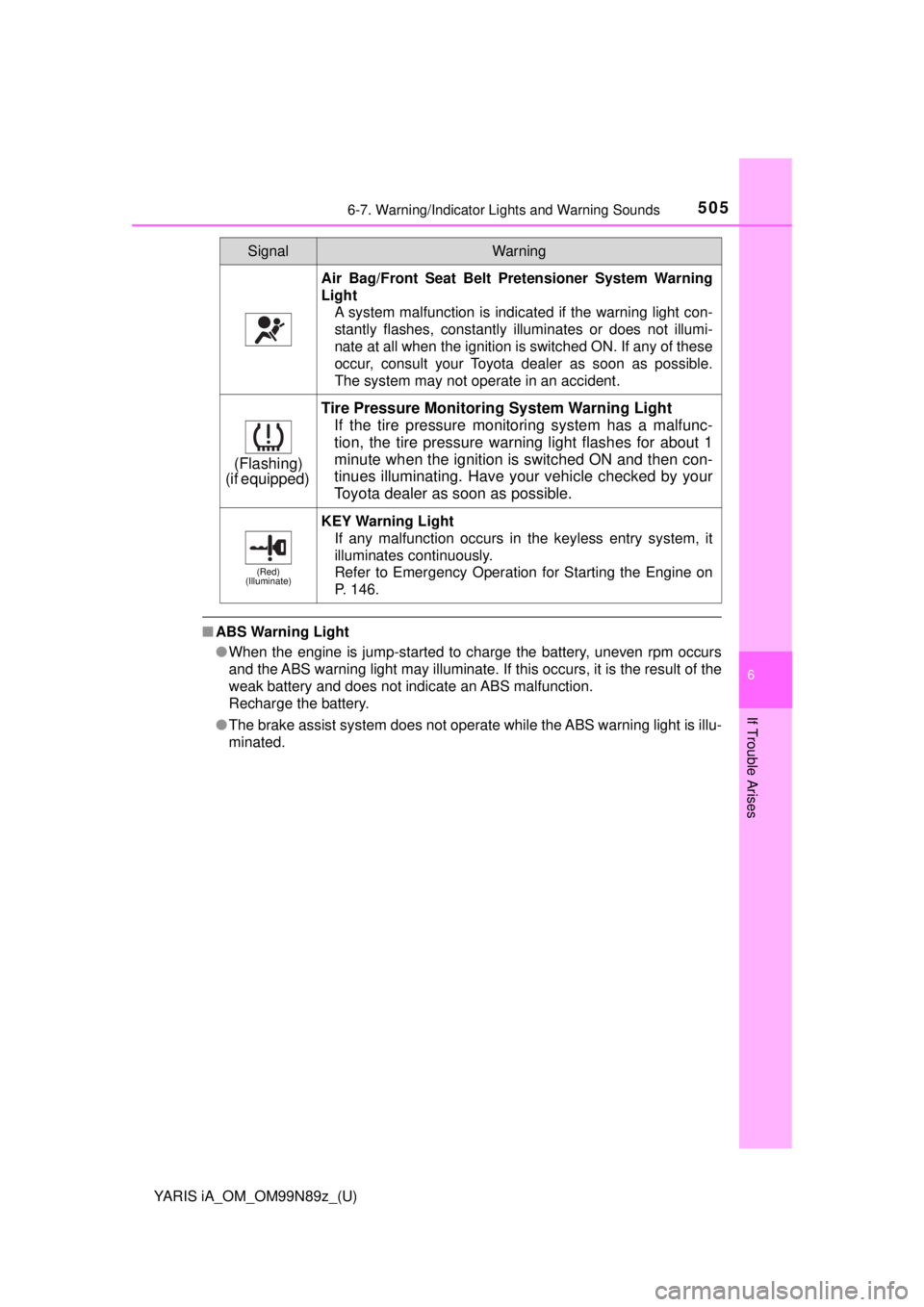
YARIS iA_OM_OM99N89z_(U)
5056-7. Warning/Indicator Lights and Warning Sounds
6
If Trouble Arises
■ABS Warning Light
●When the engine is jump-started to charge the battery, uneven rpm occurs
and the ABS warning light may illuminate. If this occurs, it is the result of the
weak battery and does not indicate an ABS malfunction.
Recharge the battery.
● The brake assist system does not operate while the ABS warning light is illu-
minated.
Air Bag/Front Seat Belt Pretensioner System Warning
Light
A system malfunction is indicated if the warning light con-
stantly flashes, constantly illuminates or does not illumi-
nate at all when the ignition is switched ON. If any of these
occur, consult your Toyota dealer as soon as possible.
The system may not operate in an accident.
(Flashing)
(if equipped)
Tire Pressure Monitoring System Warning Light
If the tire pressure monitoring system has a malfunc-
tion, the tire pressure warn ing light flashes for about 1
minute when the ignition is switched ON and then con-
tinues illuminating. Have your vehicle checked by your
Toyota dealer as soon as possible.
(Red)
(Illuminate)
KEY Warning Light
If any malfunction occurs in the keyless entry system, it
illuminates continuously.
Refer to Emergency Operation for Starting the Engine on
P. 146.
SignalWarning